Edited to add: For several years, after Larry Jordan and I established the Wildlife Conservation Pass Project, the idea of a wildlife watchers’ stamp or pass gained quite a bit traction and support. It was to be an alternative and additional revenue stream to tap into the economic potential discussed below, and also to bring added income to refuges which have been historically underfunded.
When the new administration took over in 2016, exhibiting from the start its hostility to environmental ideas, we put the project on hiatus. We hope to revisit it at some point in the future. It remains to us a viable, important, and workable solution for bringing revenue and important stakeholders to the table of wildlife decisions.
Wildlife Watchers and National Wildlife Refuges
This is a three part series about National Wildlife Refuge funding and how the current system affects land-use privileges for non-hunters and non-consumptive users. In Part 2 I interview photographer Marlin Greene who has created a No Hunting Stamp to promote awareness about hunting on National Wildlife Refuges. And in Part 3 I discuss how birders, photographers and wildlife watchers can capitalize on their economic power.
Here’s the issue. This blurb is taken from the Delevan National Wildlife Refuge site:
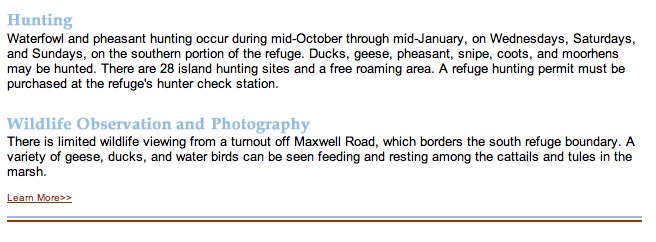
The Non-Public in Public Wildlife Refuges
Delevan is not an anomaly. When October arrives, non-hunters, birders, wildlife photographers and wildlife viewers find their access significantly curtailed in many refuges, owing to hunting priority. Some trails, boardwalks and dike loops are closed to all but hunters from October through the end of January. As the signage goes up, the “public” component of wildlife refuges fades into small cordoned-off areas adjacent to hunting zones.
In the case of refuges like Delevan (above), non-hunters are pointed to a pull-out from the road, or a driving loop with no pedestrian access. All the while, hunters fire away in free roam areas and established blinds on these refuges — which constitute large swaths of acreage designated for hunting alone.
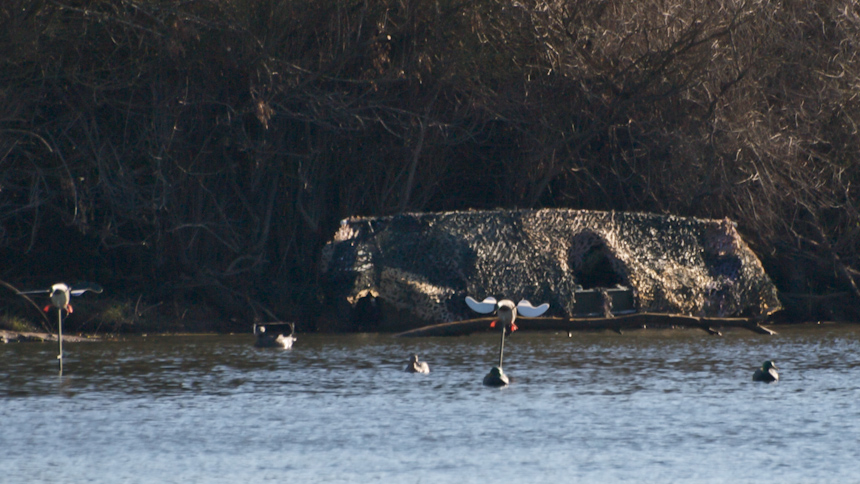
The end result is limited wildlife viewing during the height of migratory bird season, consistent hunting pressure on ducks and geese that use the refuges to rest and refuel after long migrations, significant injury rates and crippling of migrating birds, and hunting disturbance on non-target, non-game species. Depending on the refuge and the state in question, hunts occur every day of the week or on several days of the week.
In some areas, water birds get no reprieve from shotgun fire for the more than three months of hunting pressure that occurs in our wildlife “refuges.” If you’ve photographed or birded in refuges where hunting is allowed without break, you may have experience with skittish resident and migratory birds. There is disruption in hunted areas — in feeding, flocking and roosting routines. Some birds have even modified their behavior to (as one example) fly later at night, after shooting hours end.
Waterfowling publications and organizations acknowledge these behavioral disruptions when writing about how hunters can outsmart late-season ducks who’ve changed their movements to avoid hunters.
From the article Fooling Today’s Highly Educated Waterfowl (Ducks Unlimited):
“With the exception of the weather, nothing has a bigger impact on waterfowl behavior these days than hunting pressure. While duck harvests have declined in recent years from the record highs of the late 1990s, waterfowlers continue to spend more days in the field and are bagging more birds than at most times in modern history. The widespread use of ATVs, mud motors, mechanized decoys, and other high-tech gear has also made duck hunters more mobile and effective than in the past, exerting ever greater pressure on the birds. Waterfowl have reacted to the onslaught by becoming more elusive and challenging to hunt than ever before. To have consistent success in intensively hunted areas — especially on public lands — waterfowlers have to adapt their hunting tactics to the changing habits of the birds.
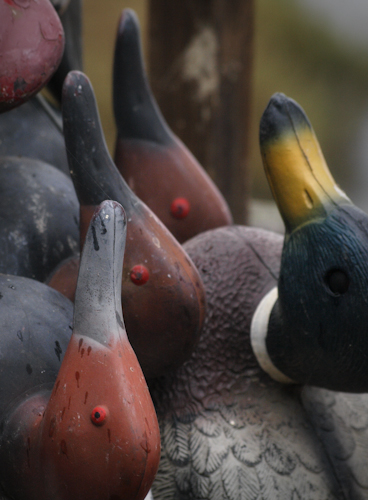
Money Changes Everything
The history of hunting on National Wildlife Refuges parallels the history of refuge funding. You can find a chronological overview of legislation here, at the Federal Duck Stamp Office website. But, in summary:
Early refuges were established to protect wildlife from the unscrupulous and indiscriminate hunting practices at the end of the 19th century. Plume hunters, market hunters and opportunists of all varieties nearly wiped out birds like egrets for their willowy plumes, and slaughtered bison for even more nefarious political reasons. The Migratory Bird Conservation Act of 1929 expanded the refuge system and “provided authorization for the acquisition of wetlands for waterfowl habitat.” With the passage of the Migratory Bird Hunting Stamp Act in 1934, a fund was created for refuge land acquisition. In 1959, Public Law 85-585 amended the Act to limited hunting opportunities to 40 percent of a refuge. The National Wildlife Refuge System Administration Act of 1966 was amended in 1978 to remove that 40 percent cap and allow hunting on more than 40 percent of refuge land.
The NRA and Hunters Have Disproportionate Influence on Wildlife Laws
In recent years, continuous pressure by sportsmens groups and the National Rifle Association (NRA) to provide more hunting opportunities on National Wildlife Refuges has resulted in refuges previously closed to hunting, now being opened to hunters. Species formerly protected on some of these refuges, are now subjected to hunting pressure, with many of these changes slipping under the public radar. Some the refuge changes are enumerated in this NRA letter to its members on the subject of the National Wildlife Refuge System Improvement Act of 1997. The letter acknowledges that the “NRA played a key role in getting language included in this act making hunting a ‘priority public use’ on National Wildlife Refuges.” In a separate NRA document, their Director of Conservation, Wildlife and Natural Resources is quoted as saying: “We have always felt confident that the language in the Improvement Act (which the NRA was involved in drafting) provided the necessary firewall against HSUS’ continuing assaults on hunting in wildlife refuges.”
This next excerpt comes the U.S. Fish and Wildlife Service document Conserving the Future: Wildlife Refuges and the Next Generation:
“There is an unbreakable bond between traditional users, such as anglers and hunters, and the Refuge System because these users depend on healthy fish and wildlife populations and habitats, and their activities are directly related to the System’s mission. We are committed to working with state fish and wildlife agencies, hunters and anglers to increase wildlife-dependent recreational uses on public lands.”
How Much Do Duck Stamps Fund?
At the crux of land-used decisions on National Wildlife Refuges is the source of funding or, rather, the attributable source. Hunters and hunting groups rationalize their priority usage by citing the Federal Duck Stamp dollars that hunters bring into refuges. Duck Stamp revenue, in sum, has purchased approximately 3 percent of the Refuge System lands. The rest of the funding is provided through Congressional appropriations, or public funds.
Here’s the funding summary from the U.S. Fish and Wildlife Service page on land acquisition:
- The sale of Migratory Bird Hunting and Conservation Stamps (Duck Stamps) have brought in about $477 million since 1934
- Another $197 million has been added to the Migratory Bird Conservation Fund (MBCF) as an “advance loan” from the Treasury
- About $153 million has been added to the MBCF from import duties on firearms and ammunition and from refuge entrance fees
- Collectively, these MBCF funds have purchased about 2.7 million acres (about 3 percent of Refuge System lands)
- Congress appropriates funds for land acquisition primarily with funding from the Land and Water Conservation Fund (LWCF) and the Migratory Bird Conservation Fund (MBCF)
- An additional 1.4 million acres (about 1.5 percent of Refuge System lands) have been purchased using about $1 billion from the Land and Water Conservation Fund
Non-Hunters and Wildlife Refuge Funding
What you don’t always hear is that some of the Duck Stamp revenue comes from non-hunting birders, photographers, stamp collectors and conservationists. As a non-hunter, if you buy your Duck Stamp at an individual refuge, that refuge may mark you in their book as hunter or non-hunter. But if you buy your Duck Stamp online, at the USPS store, or at other venues, to the best of my research on this, there is no checkbox to suggest your affiliation. I did write a letter to the Federal Duck Stamp Office, asking for a simple designation of “non-hunter” in all online forms, to more accurately track our purchases. So far, the office has been unresponsive to this request and consequently, I did not purchase my stamp.
When land use is discussed and designated, duck stamp funds are easily grouped together as revenue from hunters, for hunter PR purposes. And the current system remains, with the growing number of non-hunting, non-consumptive users having comparatively little financial or political voice to challenge the current norms. The U.S. Fish and Wildlife Service, in their 2006 survey of wildlife recreation, reports that U.S. hunters number 12.5 million while wildlife viewers number 71+ million.
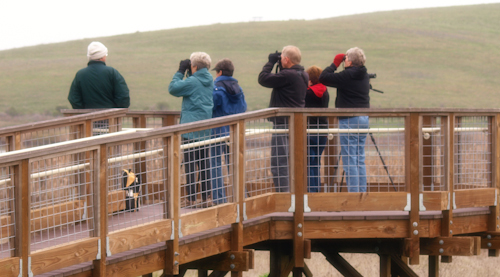
On a recent visit to a local wildlife refuge, I asked the refuge personnel if they tracked proceeds from non-hunters. I was told, “well, most of our duck stamp purchases are from hunters anyway.” My response was that it stands to reason that hunters would purchase more duck stamps at the refuge because the stamp is mandated by federal law if a person wants to hunt waterfowl there. This cycle of funding favors those who purchase the stamp, not because of any particular loyalty to conservation, but because of self-interest in hunting water birds. As stated above, non-hunters who choose to contribute to the Duck Stamp program, who want to help fund habitat acquisition and restoration on refuges, are not counted separately and thus perpetuate the status quo, for lack of viable alternatives. (In Part 2 of this series, I discuss this issue with a wildlife photographer who’s addressing this disparity by creating a No Hunting Stamp each year — to bring awareness to this issue.)
Refuge Funding and the Balance of Power
Some hunters are, indeed, aware of this imbalance and understand that if the funding structure changed to accommodate non-consumptive users like birders and photographers, more equitable usage of refuge lands would most likely follow.
Here’s one such statement, taken from a fly fishing forum (commenter’s identity removed):
I was in the meeting when Mr. _____ proposed that hikers, birdwatchers, horse riders, etc. start paying their fair share. My concern was that making them pay would give them a more important voice in the public and political arena. As it is, we hunters and fishers can pretty much protect our concerns because we are the only ones paying for it. Give the tree huggers, PETA and other non-compromising groups the right to say they are helping pay for it and you can bet some of the hunting and fishing will suffer….We must be careful who we empower.”
Because of this ongoing meme in the wildlife community — that hunters are our greatest conservationists and funders — I know birders and photographers who feel pressure to accept the current system, even as they are uncomfortable with increased hunting pressure on our public refuges. Others have decided not to purchase duck stamps for the very reasons I describe. As Mike at the 10,000 Birds blog writes:
“When it comes time to draft important conservation legislation or plan the creation a 21st Century Youth Conservation Corps, we non-extractive wildlife enthusiasts are forgotten in favor of the hook and bullet club. Apparently, when it comes time to calculate the financial contributions of the different sectors of outdoor enthusiasts, only hunters and anglers put up worthwhile cash, in part through the sale of hunting and fishing licenses.”
All of these reasons are precisely why an alternative, non-hunting revenue stream would be an effective way to bring more of us into the discussion about our National Wildlife Refuges — and to have a say in how our wild lands are managed and used, and how the wild animals on those public lands are overseen and protected. From the start, refuges have been underfunded owing to Congressional appropriations that simply don’t meet the needs of the 553 refuges in the national system. In more stringent economic times, those resources are being stretched in a way that jeopardizes the health of our National Refuge System as an entity. Read this document — Short-Changing America’s Wildlife — from CARE (Cooperative Alliance for Refuge Enhancement). It will give you a bigger picture of the budget shortfalls facing National Wildlife refuges.
As it stands today, there is no equitable access for non-hunters in the areas hunters use — even on non-hunting days at refuges. Birders and photographers could pay fees as hunters do, to access the same wetlands zones in a more balanced way. But instead, there is a huge disparity between the privileges and freedoms given to hunters on refuges, particularly in the face of how disruptive hunting is on many levels — and then, the limited privileges accorded those of us who visit refuges in less intrusive, photographic and bird-watching ways.
Non-consumptive, non-hunting users outnumber hunters significantly and our voices should be proportionally represented on National Wildlife Refuge issues. We also offer the potential of significant and, as of yet, untapped source of revenue in an economic climate where so many of our parks and wild lands are suffering for lack of available funds.
Next … Part 2: The No-Hunting Stamp
Related posts: Fly Away Home and Safe | The “Cripples” — Or Why I Hate Wing Shooting

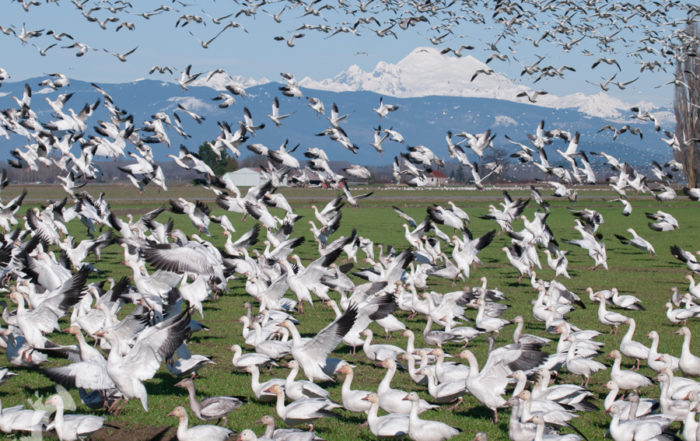
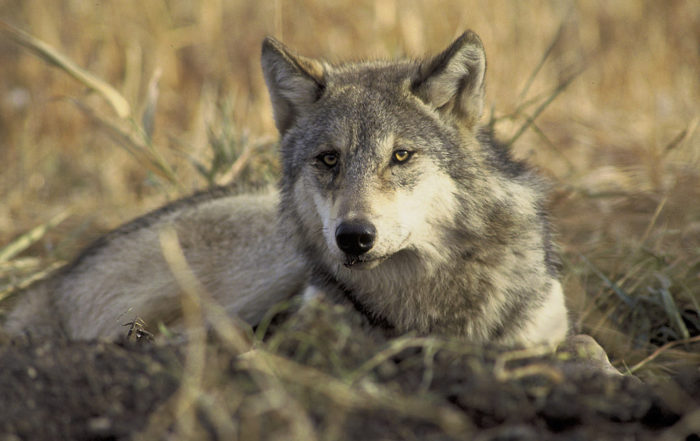
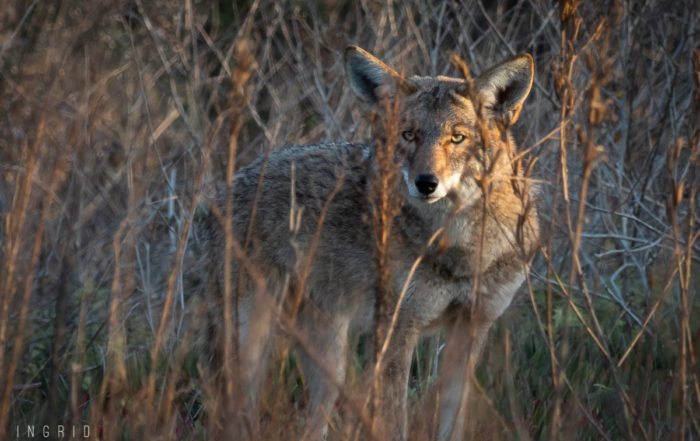
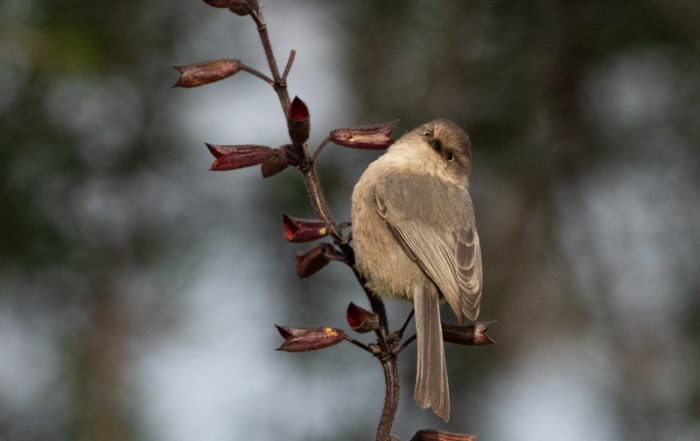
The problem is that the U.S. government got the funding mechanism wrong from the start — by not including other facets of society that also have a vested interest in creating & maintaining wildlife refuges. Birdwatching groups are the most obvious. The National Audubon Society had already been officially in existence nearly 30 years when the Duck Stamp Act came into law in 1934. Other wildlife watchers of that era should have been included, as well. Public Law 85-585 in 1959 (amending the Duck Stamp Act by limiting hunting opportunities to 40 percent of a refuge) was a step in the right direction. It also would’ve been the perfect time to augment the funding vehicle to include the aforementioned birders and wildlife watchers . . . and . . . the burgeoning new group of wildlife PHOTOGRAPHERS. Millions of Kodak Brownie 127 cameras were sold between 1952 and 1967 (my family had the Hawkeye Brownie). The 1978 amendment of the National Wildlife Refuge System Administration Act — permitting the opening of more than 40 percent of an area acquired as a migratory bird sanctuary to hunting — is a travesty. To use the terms “sanctuary” and “hunting” in the same sentence is oxymoronic. The wildlife refuge funding error — now nearly 80 years old — must be remediated. And the 1978 amendment must be repealed. Now.
Hugh, I agree with you. Thanks for the great perspective. Like you I see the history of refuge funding — into the present day — as a series of missed opportunities and lopsided priorities. Now, with wildlife watchers growing in significant numbers and hunters decreasing in numbers, the potential revenue from the rest of us, in an underfunded system, could be significant. At the same time, as a non-hunting user, I want my contribution separated as such for the very reasons we’ve already discussed. Historically, I believe Audubon has consistently supported hunting, or at least not taken an adversarial stance. So, I wonder what, if any influence, they had as an interest group, in terms of how funds were appropriated and allocated in those early days. Maybe someone who knows Audubon history better than I do can comment to this issue. The membership alone would have been cause to implement a broader view toward multiple revenue streams, don’t you think? Today, we have an opportunity toward a collective voice on this topic, seeing as how we’re 77+ million strong. We don’t, of course, have the NRA on our side.
[…] system. Ingrid Taylar at The Free Quark is in the middle of an astute inquiry into the issue of non-hunters and the NWR system as well as potential alternatives to the status quo. I urge conservation minded readers to engage […]
keep up the good work.. thank you for sharing posting. looking forward for the next post.
For anyone who’s interested in some diverse viewpoints on this issue, there’s additional discussion and debate happening over at the 10,000 Birds blog.
Ingrid, thanks for writing this article. I have long felt that there were many more non-consumptive people visiting National Wildlife refuges than have been acknowledged or accounted for, myself included. I also feel that non-hunters should have as much access as hunters do not only in our National Wildlife Refuges but in certain state parks.
Thanks very much, Mia. I realize this financial system has been in place for decades, but we non-extractive users now far outnumber hunters — and our numbers are growing, whereas the number of hunters has been on the decline. As I wrote, I believe we’re definitely ready for an alternative revenue stream … not just for us non-hunters, but for the refuges themselves. It’s heartbreaking to see the state some of our parks and lands are in with respect to lack of funding (California State Parks, as one example).
I’m very much in agreement with every word of this blog and of the comment below it.
Yes, it’s definitely bizarre to equate “hunting” with “sanctuary” or “refuge.”
It’s strange how slow those of us who do not kill animals have been to stand up for our right to at least equal time on our national lands; it’s as the hunters’ guns have been held to our heads, scaring us into submitting to their rules!
Then, too, we’ve been purposely fooled by the “closed for maintenance” signs; too few people actually ASK what that means!
I have trouble accepting the words “non-hunter” and “non-consumptive” and “non-extractive” and “non-predator.” Somehow, we’re made to sound like nobodies when we have a “non” before our name, while the hunters/consumers/extractors/predators come off as being somebodies. Ha! A sad state of affairs, isn’t it, when killers of innocents rule our language.
The word “extractor” also makes me uncomfortable in the sense that one thinks of extracting resources, like coal or gas. But animals are NOT resources. They are fellow inhabitants, fellow beings. It’s convenient and self-delusional of the killing crowd to pretend that animals are meant for their use. It reminds me of rapists who believe they have a right to violate their victims — their resources.
My fight against the “non” prefix extends to the alternate word for animals. Rather than call them nonhumans, I say: other-than-humans. But even that isn’t good enough. It makes animals sound less important.
All ideas for putting positive words back in the photographers/birders/hikers/walkers ballpark are welcome.
Hm, how about the harmless — as opposed to the harmful ?
Oh, I wanted to add: not only the Audubon, but the Sierra Club supports hunting. Thus, I don’t support it.
CQ, thanks for the most thoughtful commentary. I agree with you about the power of words, and the negative connotations of the words I used myself in this series of posts. I realize we get stuck in the vernacular of the system, and “non-hunter” and “non-extractive” have become the terms by which other refuge users are identified. (btw: even some hunters have trouble with the term “non-consumptive,” but for different reasons.They will argue we all consume something while using the land, and that it’s not just hunters who are “consumptive.”)
And yes, you’re right in saying that this language usage tends to reduce animals to “resources.” I see that as a significant and unfortunate outcome, as much as the words “cull” and “harvest” are used by hunters as euphemisms for killing. When you look at game management plans, the perspective does tend to be one of resource management, even if the “resource” is a sentient individual. Classifying wild animals as resources also leads to a lot of rationalizations about hunting and the treatment of animals, because it can be argued that the “resource” as a whole is thriving, even if individual animals are being mistreated, killed or injured.
There was a parallel discussion over at the 10,000 Birds blog, and through that thread, the term “wildlife watcher” came into use. There are various states that have passes signifying this, including Washington State where I’m living for a time. Ohio has a “Wildlife Legacy Stamp” which funds habitat and wildlife projects not associated with hunting. So, perhaps when this becomes the norm, rather than the anomaly, more positive terms will take hold to describe those of us who use public lands and who choose not to do so in a violent way.
Personally, I’ve always like the term “earthling” because it suggests parity among species. I know there was a film by that name as well. I confess that I’ve only been able to view it in small chunks, even though most of what’s depicted is footage or practices I’ve seen previously. Maybe I’ve reached my cruelty saturation point as I get older. Of course, this idea of species parity conflicts dramatically with the utilitarian and ‘superiority’ model we’ve established around our relationship to animals. I always say that if we were to substitute humans in the scenarios we inflict on animals, we wouldn’t even be able to bear the least of the tortures we inflict on them. People ridicule that idea, but I always think it’s worth considering, because it shows just how dramatic the disparity is between how we view ourselves and how we view other animals.
Thanks for the indepth response, Ingrid. I was nodding my head as I read your every word.
Yes, probably nonviolent is a more acceptable “non” term. It’s sad that if we use terms like “compassionate” or “humane” or “just” the animal-users co-opt them and pretend that THEY are feeling, thinking and acting by those standards. That’s why they have to borrow words like the euphemisms you mention, “cull” and “harvest” — plus “processing” — to cover up the truth that what they’re doing is the polar opposite of humane, just, compassionate.
Wildlife watcher works for me. Though recently I read a blog about the word “wild.” It can conjure up the notion that we’re superior to “wild” beasts. The blog suggested the adjective “free-living” animal. I rather like that!
How about if you were to visit, support, volunteer at, and photograph cows, pigs, chickens, turkeys, sheep, goats, rabbits, and other domesticated “farmed” animals at rescues and sanctuaries? Would you call yourself a Tamelife watcher (ha!)?
I like everything you say about your reasons for liking “earthling.” I think my favorite is “fellow-being,” though. It makes me think that all sentient beings are now and forever equal, linked, free, individual, complete. On earth and beyond!
I meant to say also … I haven’t had a chance to peruse all of the documents at your site, but you’ve put together a beautiful repository of quotes and thoughts on our other-than-humans.
Even suggesting that you intend to peruse all the quotes in my online book is a great compliment! Thank you, Ingrid. Oh, I love that word “repository”; I will have to start using it myself.
If you’d like to read all the anti-hunting (a.k.a. pro-free-living life!) quotations, here’s a list of names and chapters and page numbers:
Chapter 14
~ Luke Dommer, p 19
~ Dian Fossey, p 27
~ Jane Goodall, pp 33-34
Chapter 17
~ Irwin Feldman, pp 31-34
~ Dino DiGiacomo, pp 47-49
Chapter 18
~ Glenn Kirk, pp 54-57
Chapter 19
~ Ellen DeGeneris, p 5
~ Matthew Scully, pp 53-59 (esp. p 55)
~ Butterflies Katz, pp 25-31
Chapter 23
~ Len Crisfield, pp 3-4
Chapter 24
~ Thomas Eveland, pp 32-32
~ Roy Dallas Gragg, pp 42-47
Chapter 25
~ Laura Nirenberg, pp 45-47
Wish I’d known about your writing when I compiled CQ in 2009 and 2010. I’ve learned a lot by reading FreeQuark!
Oh, I meant to say that somewhere in CQ is a sparrow photo by Corey, one of the bloggers on 10,000 Birds.
Thank you for that great list! I will look them up. I like “fellow being” a lot. If you don’t mind me appropriating the term, I will use it from time to time. You’re so right about the constructs we set up. When you take social history classes, the power of language is often addressed as it pertains to historical discrimination and subjugation. I think it’s no less important how we refer to animals other than ourselves. We’ve certainly set up a damaging hierarchy and a paradigm of exploitation, with the language we’ve chosen.
Go right ahead. I notice I wrote “fellow beings” in my first post and “fellow-being” with a hyphen in my second. That inconsistency can be explained by the fact that I remembered, in post #2, that I’d borrowed the phrase from a woman who wrote in the 19th and early 20th century, when hyphens were commonly used: “fellow being” was spelled “fellow-being” and “today” was spelled “to-day.” But updating it is the correct thing to day, unless it’s part of a quote from the old days.
You might enjoy reading the excerpts in CQ from Joan Dunayer’s two books, ANIMAL EQUALITY: LANGUAGE AND LIBERATION and SPECIESISM (see Chapter 24, pp 23-30).
As I was looking those quotes up just now, I found three other things in that chapter that are up your alley, Ingrid:
~ pp 1-2 by Finnish philosopher Elise Aaltola on animals’ personhood
~ a short comment on hunting on pp 7-8 by Ron Baker
~ a not-to-be-missed photo on p. 16
Every time I look at any of CQ’s nearly 500 photos, my heart melts all over again.
Oops, I meant to write: “But updating it is the correct thing to do…” not “to day…”
I guess I’m going nuts switching from “to-day” to “today” and now to “to day.”
Re-reading a book about our kinship with animals, I came across some substitutes for “earthlings” and “fellow beings” and began to make a list. Here’s what I’ve come up with so far:
fellow beings … fellow creatures … fellow mortals … fellow animates … fellow inhabitants … fellow earthlings … fellow immortals (if one believes we all live eternally) … animal kin … planetary kin … creature kin … creature comrades … creature companions … creature cousins
Am sure there are plenty more words waiting to be discovered.
This sounds like a book you would enjoy reading, Ingrid: “A Northwoodsman’s Guide to Everyday Compassion.” Author Ken Damro is an ex-hunter/fisher/trapper/livestock farmer. Or, as a friend says, “not farmer, but harmer.”
CQ, that’s quite a list … more terminology than I’d ever considered! I like “kin” in any configuration, that’s beautiful. And I’ll be sure to check out the book. I enjoy reading perspectives from ex-hunters. I was just thinking about that this weekend, how I appreciate the insights from those who’ve had a change of heart and moved toward a different understanding about our animal kin. It helps me better understand where they were in their heads — where many are now — and what it was that inspired a different perspective. Thank you.
Ditto.
Looking through Chapter 16 of http://www.CreatureQuotes.com tonight, I found a short anti-hunting quote from Anthony Marr on pp 26-27. He travels the world lecturing on animal conservation and rights (a strange combination of topics, but true).
The reason I went back to Chapter 16 is that there’s a lovely photo on its p. 21 of rescued cougar Hallelujah, who lived as happily as is possible in a sanctuary setting at Big Cats in Tampa, FL. Recently “Hal” needed to be put to sleep. I cried when I read that sad news. Hallelujah’s lovely, serene face lives forever through Creature Quotes and through the fond memories of all who knew her.
Correction in my last sentence above: “…through the fond memories of all who knew him.”
Thank you for pointing out that lovely quote. btw, I realize I should have probably been through most of the chapters by now, but I’m taking my own sweet time reading your collections. I know I will be turning to your resources whenever I feel a sense of despondency over these issues. It helps tremendously to know that we have kindred spirits, throughout time, who shared the same concerns.
Ingrid,
First, a comment on a NWR that “got it right:” Bosque del Apache NWR in New Mexico. As I understand it, the public viewing areas are permanently off-limits to hunting. As a result, winter birding there is a joy – the bird photographer can get frame-filling shots of Sandhill Cranes, standing and in flight, as well as Snow Geese, who by the 1000s spend the afternoon nonchalantly loafing at a lake, often only 30-100′ from the viewers. Ducks and even raptors, including the normally shy American Kestrel, can also be confiding at Bosque. I wonder if birders realize that waterfowl and birds of prey, when not persecuted by hunters, will become surprisingly tame. Their ultra-wary behavior at most “wildlife refuges” is an anomaly. Likewise, waterfowl in places like Patagonia & Australia seem far more confiding than in North America which, in my opinion, is the most difficult place in the world to photograph waterfowl.
Whenever I visit Bosque in winter, I see many dozens of cars touring the loops – it is surely one of the most popular and most-visited of NWRs because of the ease in seeing and photographing bird life. Many organized birding tours also have Bosque as a destination. This must be a substantial economic benefit for Socorro, the nearest town with motels,
restaurants, etc.
At the other end of the spectrum, I just returned (a day early) from visiting Swan Lake NWR and Squaw Creek NWR in MO, realizing that mid-February is too soon after the trauma of the hunting season. The geese and ducks who survived did so by staying at least 500 yards from any road, vehicle, or person. Waterfowl photography, except for distant masses of Snow Geese, was impossible. I have visited some half dozen or more NWRs in OK, MO, & KS, but will never do so again, at least not in winter when waterfowl populations are highest.
Ingrid, if you know of NWRs that have photography blinds or substantial areas off-limits to hunting and therefore safe for waterfowl and inviting for the photographer, I would love to hear about it.
I will make it to Bosque del Apache at some point in the future. Until then, I am fortunate to live in Northern California where we also enjoy National Wildlife Refuges (NWR) where the hunting portion of the facilities are separate from the public access portions. The Sacramento National Wildlife Refuge Complex consists of five NWRs and three Wildlife Management Areas (WMA) that comprise over 35,000 acres of wetlands and uplands in the Sacramento Valley of California. There are four photo blinds that are available for reservation via a lottery in August each year, two at the Sacramento NWR, one at Delevan NWR and one at Colusa NWR. The blinds are all first rate. All but the one at Colusa have adjustable shelves with mounts for your tripod head. These refuges are all photographer friendly and offer exceptional views of waterfowl, waders and raptors as well as passerines. Great birding and photography!
Thanks, Larry … and I know you got those incredible Peregrine shots by virtue of the blind at Delevan. I’ve had an interesting education in public lands up here in Washington. Despite the abject beauty of this region, I miss Northern California very much, for the reasons you mention and many more.
Larry,
Thanks for the info on Sacramento. I was going to mention in my 1st post that Tule Lake NWR, near the Oregon border, also has blinds that are good for photography. I spent a morning in early May, 2004 in a Tule Lake blind and got goot photos of Eared Grebe, Cinnamon Teal, Ruddy Duck, Killdeer (and a starling!). What time of year is best for the blinds at Sacramento? What birds would one likely be able to photograph? Is the lottery pretty much a sure thing or a long shot?
James, thanks for the information on Bosque del Apache. Larry posted some great info on refuges in Northern California, as well. I hear so many references to Bosque, it’s been on my list of places to visit for a long time. I will respond in more depth once I have a chance to catch up on my sleep tonight, but I wanted to let you know that I appreciated your response and your insightful commentary.
James, apologies in advance for this long reply, but you got the cogs working in my head.
As far as blinds in refuges, that’s a really great question. You’ll see in my comment here that you’ve inspired a new train of research and thought. You and Larry covered Sacramento and Tule. For anyone who hasn’t been, this link has a map and descriptions of the blinds at Tule and Klamath:
https://www.fws.gov/klamathbasinrefuges/photoblind.html
Another important point: in California, on many refuges, hunting occurs only on Wednesdays, Saturdays and Sundays. It was a bit of a shock for me to move to Washington and find daily hunting in most areas, including State wildlife lands. It’s made me appreciate California’s open and protected spaces even more.
I did a bit of digging on your question this morning, because I’ve heard more mentions of NWR photography blinds in recent years, and I didn’t recall all of the locations people were mentioning. What I learned — maybe you know this — is that the NANPA has been working with FWS to install more photography blinds at refuges. This began in 1997 so, relatively speaking, it’s a newer program in the refuge system. From their list, it looks like most of the blinds have been installed in the past 12 years. You can read about that at the page below, along with the list of refuge blinds they provide. The list is incomplete since you’ll notice it doesn’t include the Sacramento NWR blinds, as one example.
https://www.nanpafoundation.org/blinds.php
They mention a photo blind grant for groups interested in installing blinds at refuges. I did not know about this, so, your comment led to some great new information, and a topic on which I might post in the blog, unless you plan to do so yourself. I’ll do some research and put together a definitive list. I see real potential here for using our numbers and our passion for photography, to bring a different element of vitality and revenue to the refuges.
I have had similar experiences to yours in terms of the behavior of birds. You notice it most profoundly when you visit a location where the animals generally have no need to be afraid. I was up at Reifel Migratory Bird Sanctuary in British Columbia last week, and it’s an extreme example of refuge comfort for birds. When I say “extreme,” I mean, that for years, the sanctuary has had bird feeders installed for songbirds, and people can toss seed to birds, which makes the refuge more like a park setting. The birds are very habituated and for me, coming from a wildlife rehabilitation mentality, this makes me quite nervous — for their well-being off the refuge. What’s different for me at Reifel is that some of the migratory duck species have no fear of humans whatsoever. A Northern Pintail will walk right up to you, as will an American Wigeon. I’ve never had that experience in my life. It made me wistful for a Snow White type of existence in the forest.
A few other things I wanted to mention about Northern California. Have you spent much time photographing there? My home is the SF Bay Area, although I’m in the Northwest/Seattle for a time. One of the reasons I cherish the Bay Area so much is because of its regional park systems. There are so many protected areas, green spaces, and wilderness tracts surrounding San Francisco Bay that belong to the city, East Bay, Peninsula or other local entities which do not permit hunting in the parks. And yet, the habitat areas are wild enough to attract bountiful birds and other animals (bobcats, elk, deer, etc). The vast numbers of shorebirds is what I miss the most.
There are countless photo opportunies which never require sharing the land with hunting interests. There are some hunting areas along the South Bay, in former salt ponds and on Don Edwards NWR, but even at Don Edwards, you can meander quite far from the hunting zones, in the non-hunting area. There is diving duck hunting on San Pablo Bay and Suisun Marsh (north bay)– a zone where I’ve had to report people for hunting violations, unfortunately. But again, it can all be pretty much avoided by the photographer.
The California State Parks have also been a dream for me in terms of photography, because they cover such a vast array of terrain and habitat for wildlife. I fear for their future, with 70 parks now on the chopping block, financially speaking. But, again, the combination of these many protected lands allows for more placid photography and hiking options during the height of the hunting season.
My biggest frustration with the refuge system is actually the length of the season. If it has to be, why not a compromise in length for the non-hunters who also come to see the wintering birds? I tend to avoid most NWRs during this time, for the reasons you mention. This is where I see something like a non-hunters or Wildlife Watchers’ stamp as critical to establishing just how great our potential is for the refuge system at large.
Ingrid,
I really enjoy your photos and blog – you have a good eye for photography, and as well, you are a good writer. I hope you’ll continue to post info here on blinds, no-hunting zones on public land, etc where the photographer has a chance for that great photo.
Not to get too far off topic, but in Texas I have photographed many birds, from Lesser Prairie Chickens to Green Jays, on private ranches that have set up permanent or temporary blinds for the photographer. They are scattered about, such as Red Creek Nature Ranch near Junction, TX, but most are in south Texas – Martin Refuge and Santa Clara Ranch, for example. The charge for using their blinds for a day is not inconsiderable, but I don’t mind, partly because it promotes the idea that there are economic benefits to maintaining habitat for non-game animals and especially bird life.
Ingrid, I visited the Bay Area when my younger daughter was a grad student at Berkeley, but coming from a small town in OK, I was rather intimidated by all those roads and that traffic!! However, I once tracked down and photographed an endemic wildflower, Tiburon Mariposa Lily, at Ring Mountain Preserve in Marin County.
James, I will definitely do so. Thanks to your question, I’m starting a list and will post as soon as I’ve researched it. It’s interesting you mention the private ranches, because in April, I’ll have my first such experience in the Monterey area of California, on a non-hunting, photography-only ranch. I won it as a prize in a photo contest, and am so excited to experience that. If you’re comfortable saying … what types of prices do places like the ones in Texas normally charge? I did a quick look at the websites but didn’t see a price outline. I wish I had the means to buy up huge tracts of land, preserve them for wildlife, then offer a few blinds to photographers at nominal fees. Why couldn’t I have been born a Getty?
oh, p.s., I keep meaning to say this. I’m so enjoying your pictorial travel diaries. I have no issue with living vicariously through beautiful imagery.
Ingrid,
Congratulations on winning a prize in that photo contest. What birds will you likely photograph at the ranch in the Monteray area? I suppose in April you’ll be getting the migrants. As far as the charge at those TX ranches, the number $125/day comes to mind. You would not want to spend a week at those prices, but in the right time & place, one can get dozens of good photos in a few hours.
Despite the disappointment of my MO trip, I had a very cooperative Short-eared Owl at Eagle Bluffs Conservation Area near Columbia. It came out well before sunset and hunted in a marsh east of my car, which meant the sun was at my back. I’m posting some flight shots in a few days.
Do you get many Chestnut-backed Chickadees and/or Varied Thrushes in your area? I’ve never photographed in the Pacific NW – those are 2 birds on my want list. They are quite handsome, judging from the photos I’ve seen posted on the internet.
[…] in comparable numbers. When it comes to forms of wildlife “recreation” in the U.S., hunters are a minority — but they are a vocal and organized minority. It was strong pressure from hunters and […]
[…] I’ve written on the subject of hunting since I first posted Fly Away Home (and Safe): 1) Non-Hunters and National Wildlife Refuges, and 2) The “Cripples” — or Why I Hate […]